Success is often a hard thing to measure, partly because it can mean such different things to different people. Yet, no matter what definition you use, learning computational thinking can be a huge help. It’s simply an amazing way of getting kids ready to take on the world, both in and out of the classroom.
What is computational thinking?
Before we can really talk about the benefits of computational thinking, we first need to define it.
Computational thinking is the process of thinking through a problem step by step in a measured and logical manner. It’s like how a computer works through its programs in a logical progression.
Computers work programmatically, following a set number of prescribed actions to solve complex problems. In the same way, computational thinking allows kids to break down complex problems of their own into more manageable steps. That way, they can better understand the problem at hand and solve it themselves!
Computational thinking examples
However, computational thinking is a lot more than just following directions. It’s more like a complete set of skills that help you think through a problem and understand the process so it will be easier the next time around.
Computational thinking is typically considered to be a combination of four simpler skills:
- Decomposition
- Pattern Recognition
- Pattern Abstraction
- Algorithmic Design
It may sound intimidating, but your kids are likely already practicing this set of skills.
In the real world, computational thinking is used in any activity that takes a series of steps to complete. That can look like anything from following a recipe to using the directions that come with a LEGO set to finish a new build.
One example is learning to make a lasagna. You start by breaking the recipe down into its different steps (decomposition). You might notice that the layers of the lasagna repeat in a pattern (pattern recognition), which in turn helps you speed things up a bit (pattern abstraction). And once you’re done, not only do you have a tasty dish, you also know how it’s done so you can explain the process to someone else (algorithmic design)!
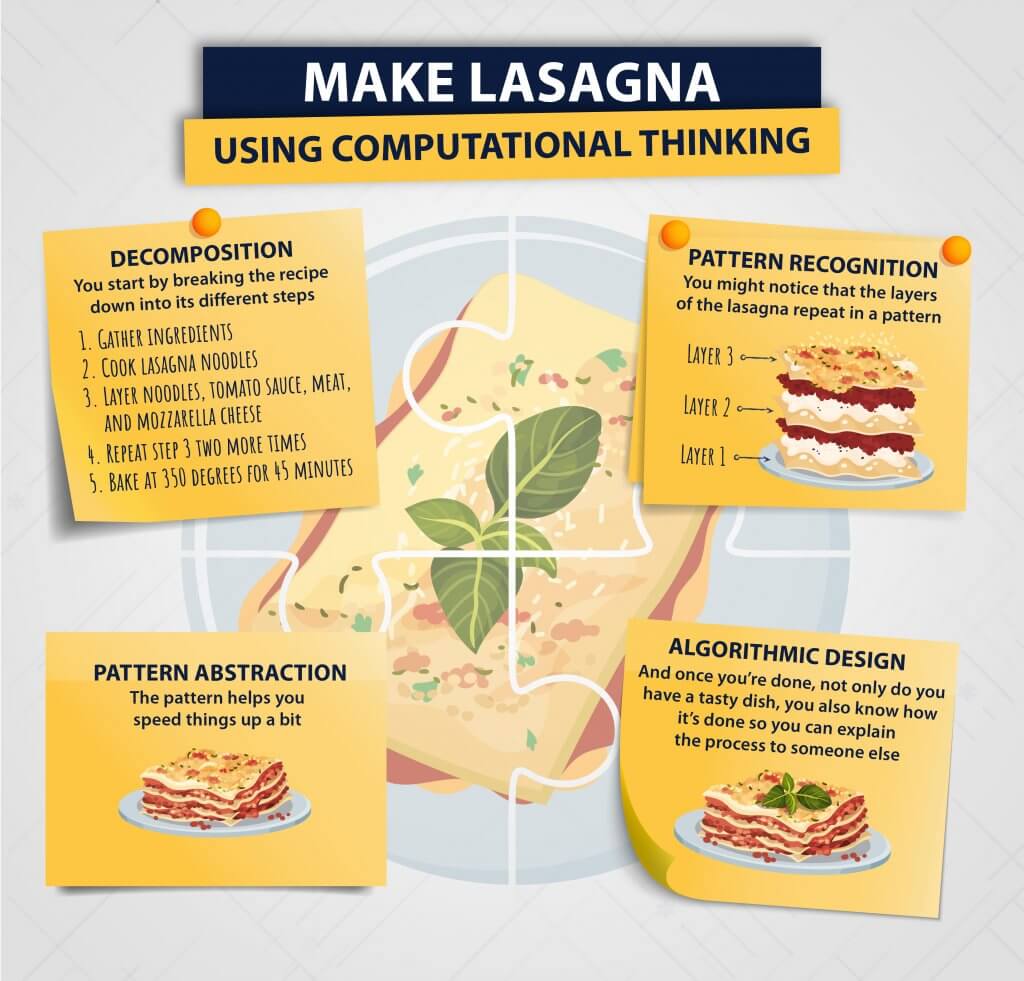
Computational thinking skills
Let’s take a closer look at each of the computational thinking skills to get a better feel for each concept and how it works.
Decomposition
Decomposition is the process of breaking something down into its component parts. In the lasagna example above, that involves taking the task of “making a lasagna” and breaking it into simpler steps. These steps could be preparing the ingredients, building the layers, and baking the dish. Each step can be decomposed further until they arrive at their simplest forms. These are the instructions that need to be followed to successfully complete the larger task.
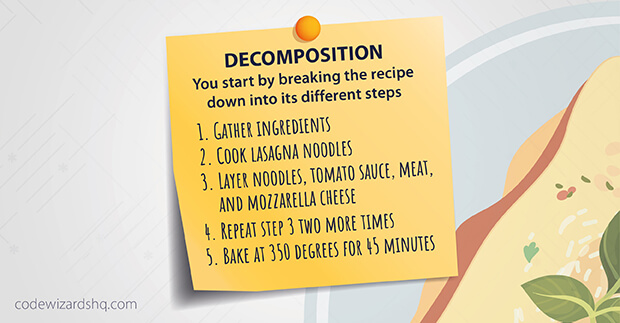
Pattern recognition
Pattern recognition is the ability to spot the instructions that repeat. For instance, when you are building the layers of the lasagna, you have to lay down pasta, sauce, and cheese a few different times to succeed. The repetition of these steps is a pattern that can be recognized.
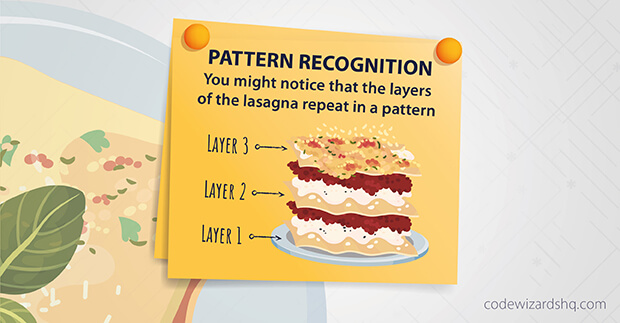
Pattern abstraction
Pattern abstraction is the process of taking the patterns you’ve identified and using what you know about them to make the process quicker! So, since you’ve noticed the pattern for layering the ingredients, you don’t have to read each line item over again. Instead, you can combine those simpler steps into the more complex task of adding a layer. That saves some time and minimizes the number of tasks that you need to think about.
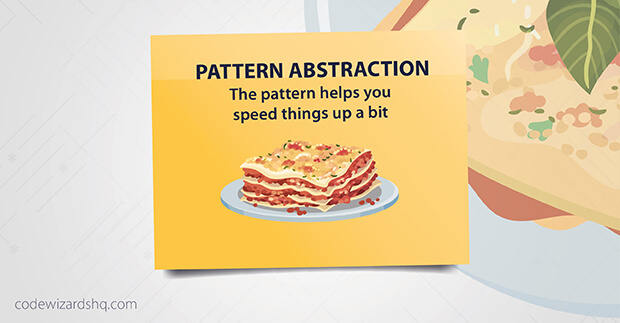
Algorithm design
Algorithm design is simply the process of ordering the steps so you (or someone else) can follow them to come out with the correct results every time. Designing an algorithm for the process of making a lasagna would be the process of writing down the recipe for future use.
While the lasagna in our example probably already has a recipe written out for it, that’s not always the case when solving other problems. If you put in the hard work of breaking down a large task into its components and using patterns to streamline the process, algorithmic design ensures that that work doesn’t go to waste.
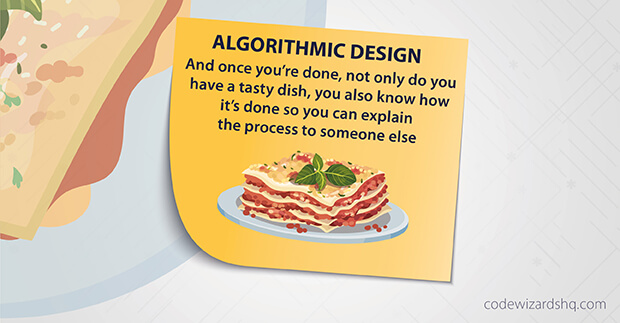
Why computational thinking is important
The biggest benefit of computational thinking is how it enables real-world problem solving. For kids, knowing how to take large problems and break them into simpler steps can help with everything from solving math problems to writing a book report. How many times has your child been overwhelmed by a new concept or project in school? Just taking things one step at a time can eliminate much of this anxiety.
And that’s just one of the ways that computational thinking can be helpful. Another is through pattern recognition abstraction.
How often do the problems we face have a pattern to them? Being able not only to spot those patterns but to also be able to make changes to address them is a huge benefit that comes from thinking computationally.
Coding helps kids develop computational thinking skills
So, how can you help kids learn and master computational thinking?
There are many different paths you can take to teach computational thinking. It could be activities in the kitchen, or practicing mathematical equations. But possibly the best way to practice computational thinking is through helping them learn how to code!
Coding has a distinct advantage over other methods, because computational thinking is such a major component of every stage of coding, from beginning to end.
Courses like the ones we teach at CodeWizardsHQ are a highly effective way to help kids learn computational thinking. They help kids of all ages improve their problem solving skills. And with classes for students in elementary, middle school and high school, CodeWizardsHQ has classes for everybody!
Free Computational Thinking Activities
These free activities can also help you get a jump start on introducing your kids to computational thinking. These are great to check out before your child starts learning how to code and to come back to if there’s a situation your child is struggling with that could benefit from computational thinking.
- Organize Clean Dishes Computationally
- Ultimate Back Packing Game
- Analyzing Code as Data
- Game with No Instructions
- Sequencing and Looping Puzzles
- Sorting Networks
- Design Thinking Challenge
- Program-Python: Two Workers
- Program-Python: Vertex of a Quadratic
- Choose Your Own Adventure: A Hypertext Writing Experience
